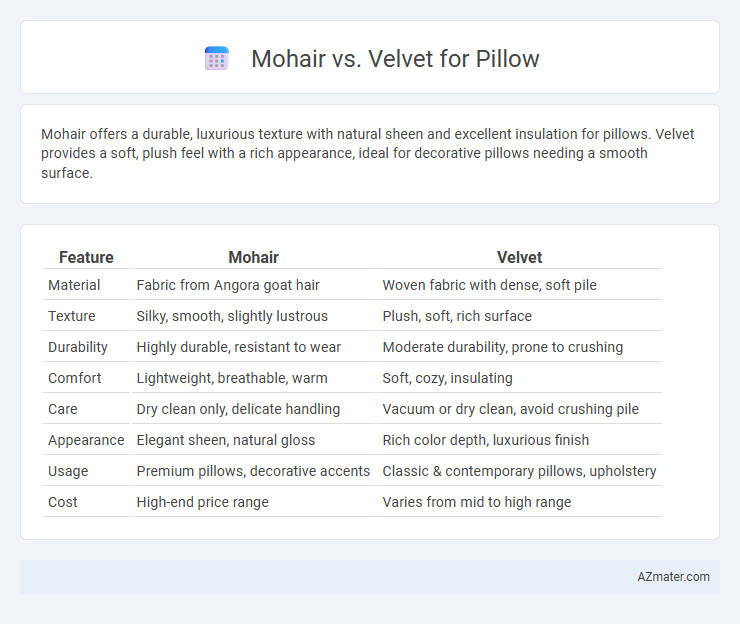Mohair offers a durable, luxurious texture with natural sheen and excellent insulation for pillows. Velvet provides a soft, plush feel with a rich appearance, ideal for decorative pillows needing a smooth surface.
Table of Comparison
| Feature | Mohair | Velvet |
|---|---|---|
| Material | Fabric from Angora goat hair | Woven fabric with dense, soft pile |
| Texture | Silky, smooth, slightly lustrous | Plush, soft, rich surface |
| Durability | Highly durable, resistant to wear | Moderate durability, prone to crushing |
| Comfort | Lightweight, breathable, warm | Soft, cozy, insulating |
| Care | Dry clean only, delicate handling | Vacuum or dry clean, avoid crushing pile |
| Appearance | Elegant sheen, natural gloss | Rich color depth, luxurious finish |
| Usage | Premium pillows, decorative accents | Classic & contemporary pillows, upholstery |
| Cost | High-end price range | Varies from mid to high range |
Introduction to Mohair and Velvet Fabrics
Mohair, derived from the Angora goat, is a luxurious fiber known for its sheen, durability, and natural resilience, making it ideal for pillow coverings that require softness and longevity. Velvet, traditionally made from silk but now also crafted from cotton, polyester, or blends, offers a plush texture with a dense pile that provides a rich, tactile experience and vibrant color depth. Both fabrics elevate pillow aesthetics, with mohair excelling in warmth and velvet in luxurious softness, catering to different design and comfort preferences.
Key Differences Between Mohair and Velvet
Mohair pillows feature fabric made from the long, silky hair of the Angora goat, offering exceptional durability, natural sheen, and breathability, while velvet pillows use densely woven fibers like silk, cotton, or synthetic blends, providing a plush texture and rich color depth. Mohair is known for its moisture-wicking properties and resistance to crushing, making it ideal for pillows that retain shape and comfort over time. Velvet, in contrast, excels in softness and luxurious appearance but requires more delicate care to maintain its smooth, dense pile and avoid pressure marks.
Texture and Feel: Mohair vs Velvet Pillow Covers
Mohair pillow covers offer a luxurious, silky texture with a natural sheen and a soft, lightweight feel that adds an elegant touch to any room. Velvet pillow covers provide a plush, dense texture known for its rich, smooth surface and heavier, cozy feel that enhances warmth and comfort. Both materials excel in softness, but Mohair is preferred for its airy smoothness while Velvet is favored for its sumptuous thickness and tactile depth.
Durability and Longevity Comparison
Mohair pillows offer exceptional durability due to their strong, resilient fibers that resist wear and maintain texture over time, making them ideal for long-term use. Velvet pillows, while luxurious and soft, tend to show signs of wear more quickly, including pilling and flattening, especially in high-traffic areas. The natural resilience of mohair ensures superior longevity compared to velvet, which requires more delicate care to preserve its appearance and texture.
Maintenance and Cleaning Requirements
Mohair pillows require gentle cleaning methods such as spot cleaning with mild detergent and air drying to maintain their natural fibers and softness, while velvet pillows necessitate regular vacuuming to prevent dust buildup and often benefit from professional dry cleaning to preserve their plush texture. Both materials are sensitive to harsh chemicals and excessive moisture, making prompt stain treatment essential to avoid damage. Proper maintenance extends the lifespan of mohair and velvet pillows, ensuring they retain their luxurious appearance and comfort.
Allergen Considerations for Pillows
Mohair pillows offer a hypoallergenic option due to their natural resistance to dust mites and mold, making them suitable for allergy sufferers. Velvet pillows, often made from synthetic fibers or cotton blends, may trap more allergens like dust and pet dander unless treated with anti-allergen finishes. Choosing mohair over velvet can reduce the risk of allergic reactions and improve overall sleep quality for individuals with sensitivities.
Color and Design Versatility
Mohair offers a rich, natural sheen and a soft, luxurious texture that enhances color depth, making it ideal for muted, elegant tones and subtle color shifts in pillow design. Velvet provides a plush, smooth surface with vibrant color saturation and a reflective quality that intensifies hues, perfect for bold, dramatic, and richly textured pillow aesthetics. Both fabrics excel in design versatility, with mohair favoring sophisticated, understated palettes and velvet enabling a broader spectrum of vivid color options and intricate patterns.
Suitability for Different Home Styles
Mohair pillows offer a luxurious, textured look ideal for rustic, bohemian, and eclectic home styles, enhancing warmth and depth with their natural sheen and softness. Velvet pillows suit modern, glam, or traditional interiors by providing a smooth, rich surface that exudes elegance and sophistication. Both fabrics are versatile but choosing mohair adds a tactile, cozy element, while velvet emphasizes refined, polished aesthetics.
Price and Value: Mohair vs Velvet
Mohair pillows generally come with a higher price tag due to the luxurious nature of the fabric derived from Angora goats, offering exceptional softness and durability. Velvet pillows, often made from cotton, polyester, or silk blends, provide a more affordable option while maintaining a plush texture and elegant appearance. When considering value, mohair offers long-term investment through longevity and unique texture, whereas velvet delivers versatility and style at a budget-friendly cost.
Conclusion: Choosing the Right Fabric for Your Pillows
Mohair offers a luxurious, soft texture with natural durability and breathability, ideal for pillows in elegant, cozy settings. Velvet provides a rich, plush feel with vibrant color options and a smooth surface, perfect for adding a touch of sophistication and warmth to any room. When choosing between mohair and velvet for pillows, consider factors like desired texture, maintenance level, and aesthetic preference to enhance both comfort and style.

Infographic: Mohair vs Velvet for Pillow
 azmater.com
azmater.com